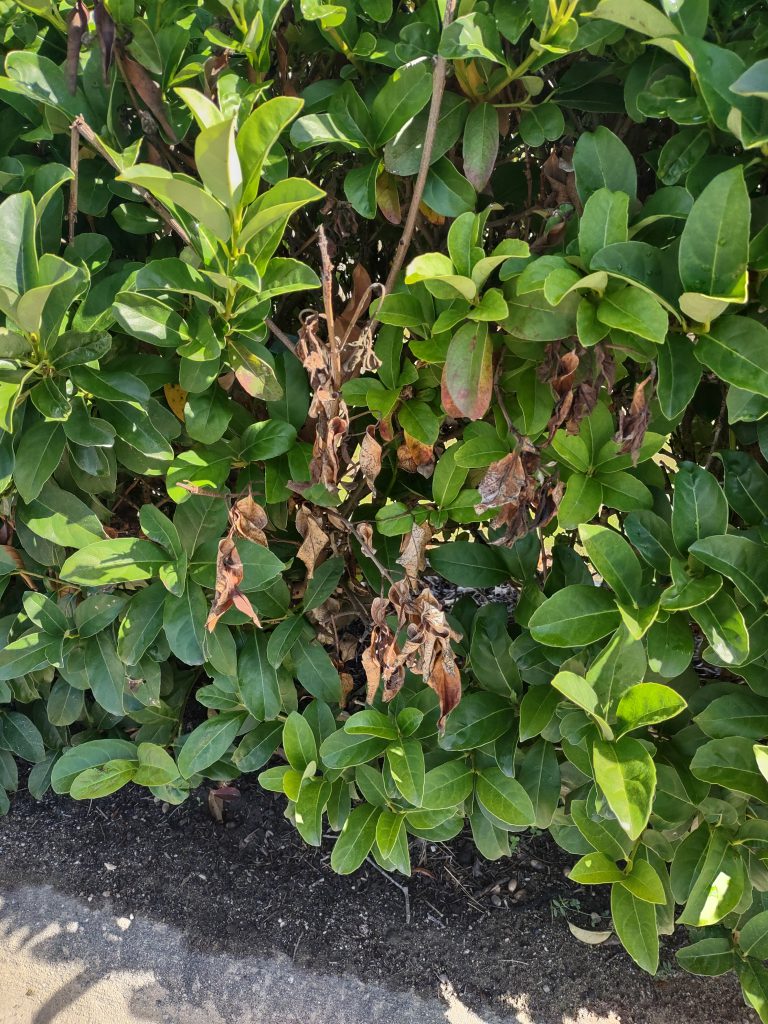Sweet Viburnum (Viburnum odoratissimum) is thought of as being an ironclad landscape shrub, generally a rapid, healthy grower free of insects and disease. However, this spring, many Sweet Viburnum specimens across the Panhandle have experienced varying degrees of dieback, from individual shoots to entire sections of shrubs, caused by the fungal pathogen Botryosphaeria – commonly known as Bot Rot.

Bot Rot almost always appears after some kind of major stress event that impacts susceptible plants – drought, pruning wounds, nutritional deficiencies, or another environmental stress. We haven’t been afflicted lately with any serious drought conditions and the disease occurrences are too widespread to have been a result of isolated pruning or poor plant nutrition. However, the Panhandle did experience a major environmental event around Christmas 2022 that was plenty stressful for landscape plants, a weeklong Arctic blast of extreme cold. This abrupt hard freeze event in an otherwise mild winter is my best guess for what brought about the increased incidence of Botryosphaeria we have experienced this spring.
The Botryosphaeria fungus enters plants via wounds – in this case one probably caused by cold – and begins destroying the plant’s vascular system in the area. As the pathogen progresses, it eventually causes sunken cankers to appear, girdles the affected branch, and cuts off “circulation” in that stem. The first symptom of Bot Rot that gardeners notice is shoots rapidly wilting and exhibiting a blighted appearance, with brown, dead leaves holding onto affected limbs. Unfortunately, dieback isn’t always limited to individual shoots and can spread back into plants to eventually encompass whole branches. Entire plants dying from Bot Rot infection is not uncommon.
While there aren’t any fungicides that are effective in controlling or preventing Bot Rot, gardeners can arrest its spread by pruning out infected branches. To completely rid the plant of the fungus, make sure to prune 4” or so below the last infected plant tissue (symptomatic tissue will appear dark and discolored; healthy tissue will appear light and greenish). After pruning each affected plant, it is important to sanitize pruning equipment with either a 10% bleach solution or 70%+ isopropyl alcohol to prevent spreading pathogens to other healthy plants! Plants that have been irreparably disfigured by Bot Rot or outright killed may be pulled and discarded offsite.
While this year’s Bot Rot infestation has been extremely frustrating and similar future freeze events can’t be ruled out, gardeners should not give up on Sweet Viburnum, an excellent specimen or screening shrub. Keeping plants healthy with proper pruning, good fertility, and adequate irrigation is the best defense to ward off future infection when we experience harsh environmental conditions! For more information on Bot Rot, Sweet Viburnum, or any other horticultural topic, contact your local UF/IFAS County Extension Office! Happy Gardening.
- Doveweed Control in Centipedegrass Lawns & Landscaped Beds - June 5, 2025
- Another Plea to End Crape Murder - April 21, 2025
- Roadside Red Blooms – Red Maples Showing Off This Spring - March 6, 2025
